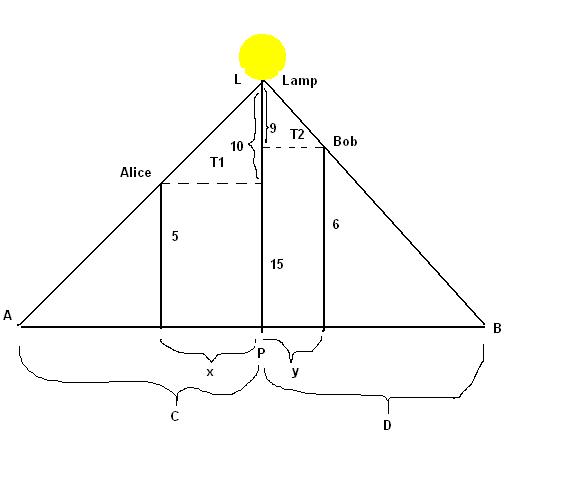Science:Math Exam Resources/Courses/MATH104/December 2012/Question 05 (b)
{{#incat:MER QGQ flag|{{#incat:MER QGH flag|{{#incat:MER QGS flag|}}}}}}
• Q1 (a) • Q1 (b) • Q1 (c) • Q1 (d) • Q1 (e) • Q1 (f) • Q1 (g) • Q1 (h) • Q1 (i) • Q1 (j) • Q1 (k) • Q1 (l) • Q1 (m) • Q1 (n) • Q1 (o) • Q2 (a) • Q2 (b) • Q2 (c) • Q2 (d) • Q2 (e) • Q3 • Q4 (a) • Q4 (b) • Q4 (c) • Q5 (a) • Q5 (b) • Q6 (a) • Q6 (b) • Q6 (c) • Q6 (d) •
Question 05 (b) |
|---|
|
Alice is 5 ft tall and Bob is 6 ft tall. At some instant they are both walking towards a street lamp 15 ft high with Alice west of the lamp and Bob east of the lamp. Suppose at this instant, Alice is walking at 4 ft/s and the distance between the tips of their shadows is decreasing at 11 ft/s. How fast is Bob walking? |
|
Make sure you understand the problem fully: What is the question asking you to do? Are there specific conditions or constraints that you should take note of? How will you know if your answer is correct from your work only? Can you rephrase the question in your own words in a way that makes sense to you? |
|
If you are stuck, check the hints below. Read the first one and consider it for a while. Does it give you a new idea on how to approach the problem? If so, try it! If after a while you are still stuck, go for the next hint. |
Hint 1 |
|---|
|
This question heavily relies on understanding the problem and the diagram in part (a) and thus all notation here out refers to the diagram in part (a). The diagram labels the important triangles and values. The key relationships needed are in (from Alice's head to the lamp post to L), triangle APL, (from Bob's head to the lamp post to L), and triangle BPL. Let C denote the length of the segment AP and let D denote the length of the segment BP. The next hints will be successions of understanding what the values are with respect to these letters. |
Hint 2 |
|---|
|
We are given that (notice that the negative is here since the size of x is decreasing over time as Alice and Bob are walking towards the lamppost). Notice that the distance between the tips of the shadows is given by . Thus, we are also given that (notice that the negative is here since the distance is decreasing over time as given by the question). |
Hint 3 |
|---|
|
Bob's distance to the lamp is y and so the speed he is walking is
What do we expect the sign of this number to be in the end? Use similar triangles for the triangles mentioned in hint 1 using the picture from part (a) and relate all these hints to create a solution. |
|
Checking a solution serves two purposes: helping you if, after having used all the hints, you still are stuck on the problem; or if you have solved the problem and would like to check your work.
|
Solution 1 |
|---|
|
The diagram from part a has been recopied for ease of reading Proceeding via the hints, we are interested in solving for . We first note that triangles and triangle BPL are similar (they share an angle and both contain a 90 degree angle). Thus, we have that
Multiplying by 15, reducing and differentiating with respect to time gives
To solve for we will need , the speed at which Bob's shadow tip is changing. To do this we consider that the distance between the two tips is decreasing by 11ft/s and so
To determine we turn to the similar triangle problem for Alice. Triangles and triangle APL are similar (they share an angle and both contain a 90 degree angle). Thus, we have that Multiplying by 15, reducing and differentiating with respect to time gives We are given that and so we have that
Therefore we have that and finally then that and so Bob is walking towards the lamppost at 3ft/s. Notice the sign we get makes sense because we are told that each person is walking towards the lamp in the question! |
Solution 2 |
|---|
|
The diagram from part a has been recopied for ease of reading Proceeding via the hints, we are interested in solving for . We first note that triangles BBob and triangle BPL are similar (they share an angle and both contain a 90 degree angle). Thus, we have that
Multiplying by 30, reducing and differentiating with respect to time gives
To solve for we will need , the speed at which Bob's shadow tip is changing. To do this we consider that the distance between the two tips is decreasing by 11ft/s and so
To determine we turn to the similar triangle problem for Alice. Triangles AAlice and triangle APL are similar (they share an angle and both contain a 90 degree angle). Thus, we have that Multiplying by 15, reducing and differentiating with respect to time gives We are given that and so we have that
Therefore we have that and finally then that and so Bob is walking towards the lamppost at 3ft/s. Notice the sign we get makes sense because we are told that each person is walking towards the lamp in the question! |
{{#incat:MER CT flag||
}}




















